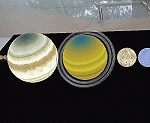2009 Campus Technology Innovators: Immersive Learning
- By Mary Grush, Matt Villano
- 08/01/09

THE IMMERSIVE EDUCATION Mixed Reality Table allows students to physically
manipulate 3D virtual models and design experiments on the fly.
IMMERSIVE LEARNING
Innovator: The Media Grid Immersive Education Initiative
A breakthrough in interactivity, the Immersive Education
Mixed Reality Table merges 3D virtual objects and environments
with physical objects from the real world.
The key to effective use of a 3D immersive environment for
education may be an intuitive, natural mode of interaction for
its users. Working with the Media Grid Immersive Education
Initiative, an international nonprofit consortium of education
institutions, Aaron Walsh, director of The Grid Institute and a
faculty member at Boston College, led a collaboration with
the Mixed Reality Lab at the National University of Singapore to develop a tool to merge 3D virtual and physical worlds:
the Immersive Education
Mixed Reality Table (iED
Table). Wearing 3D goggles,
students can interact
physically with a 3D
immersive virtual environment
that"pops up" from the 2D surface of the iED Table.
"The iED Table dramatically changes the way in which students
interact with computer-based learning environments by
combining, or 'mixing,' the real world with the virtual world,"
Walsh explains."This innovation in human-computer interaction
is achieved by superimposing synthetic 3D virtual worlds
and objects onto any surface in the real world, such as
a table, desk, or floor. Students use their hands and
bodies to interact with the virtual worlds and objects
that appear on the iED Table in the same way that
they interact with real-world objects. Virtual learning
environments can be interacted with in a natural
and intuitive way that enhances the overall learning
experience."
Though the iED Table is a brand-new introduction,
a few simple, concrete demonstrations of the newly
announced table are already providing a starting point
for development of curricular applications of the technology
in higher education. In one demonstration,
astronomy students not only learn about the solar system,
but also interact with a 3D virtual model and
design experiments on the fly. Students place a virtual
sun and planets onto a real tabletop-- set in physical
space in their classroom. By changing the size of
the planets and their relative positions to the sun, the
students can observe the effects of mass and gravity
on their virtual planets' orbits. Students can devise a
wide range of"what if" scenarios as they interact
directly with the model, moving planets around at willand changing the size and mass of the planets and the sun.
Students also can cut the planets and sun open, exposing
inner structures such as the core and layers of the earth or the
molten materials inside of the sun.
A major development
priority is to make the iED
Table compatible with
virtual platforms in use
around the globe.
In another example, botany students can run seed germination
experiments with virtual versions of some of the same
laboratory supplies they'd use in a physical lab. Though such
experiments could also be run exclusively in"real" physical
spaces, using the iED Table offers many advantages in setting
up and modifying variables quickly and efficiently. For
instance, students may watch the sprouts emerge from the
soil and grow into full-sized plants in a time-lapse sequence,
then reset their variables and begin again-- several times during
the course of one lab period.
A major development priority for the Media Grid Immersive
Education Initiative is to make the table compatible with virtual
platforms in use around the globe. By using Immersive Education
Initiative technology standards, the iED table will
interact with a wide range of virtual platforms, such as Project
Wonderland from Sun Microsystems, realXtend, and Open
Cobalt. Practicality and price point were also important priorities
in the development of the table, as Walsh expects the
technology to be affordable and used widely. The Media Grid
Immersive Education Initiative's ultimate goal is to offer the
table as a commercial-grade technology free of charge to the
global academic community.
About the Authors
Mary Grush is Editor and Conference Program Director, Campus Technology.
Matt Villano is senior contributing editor of this publication.